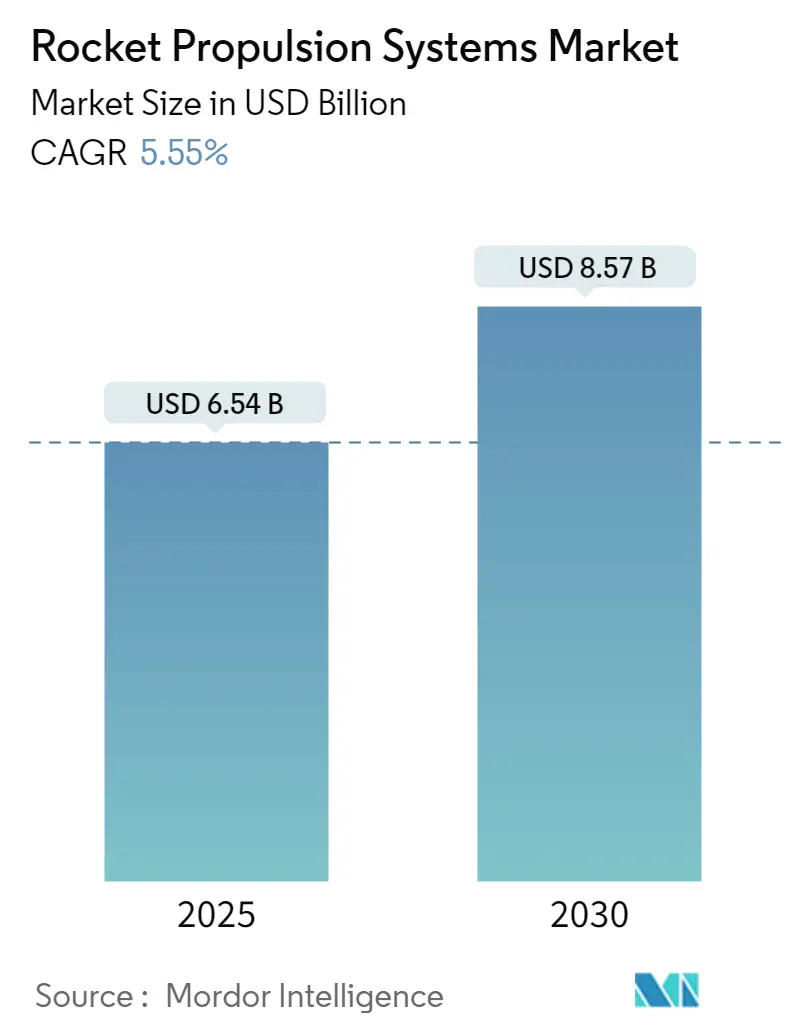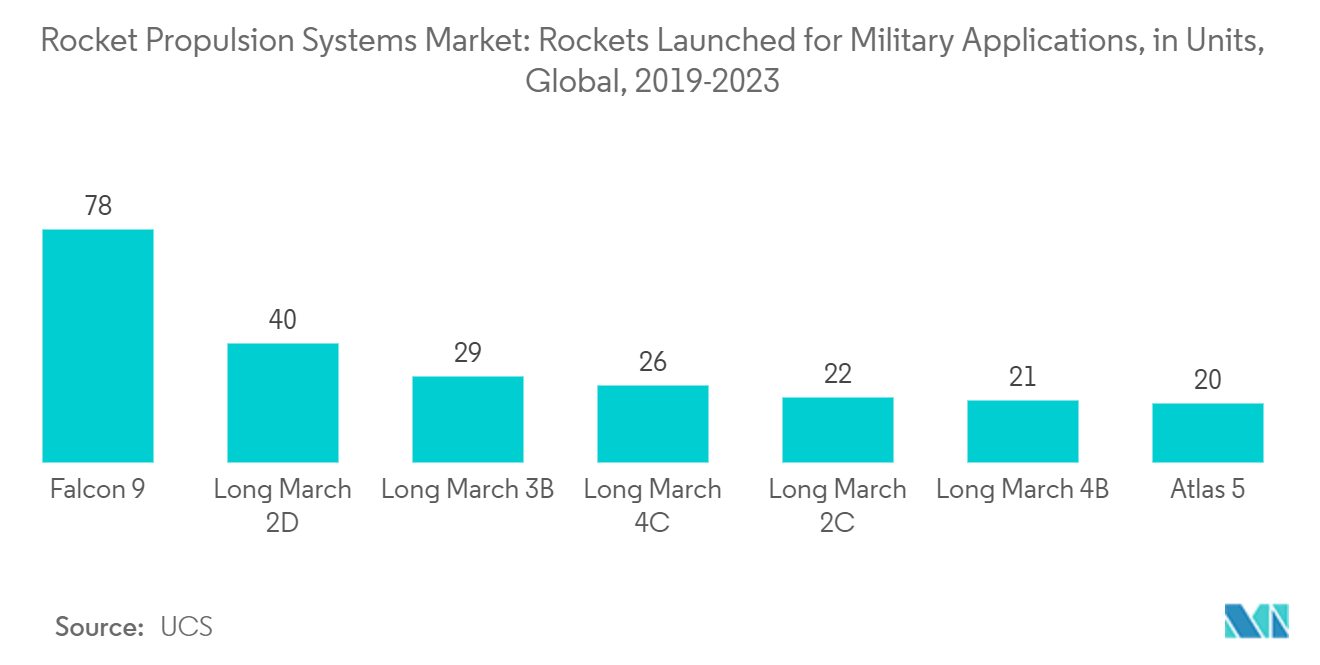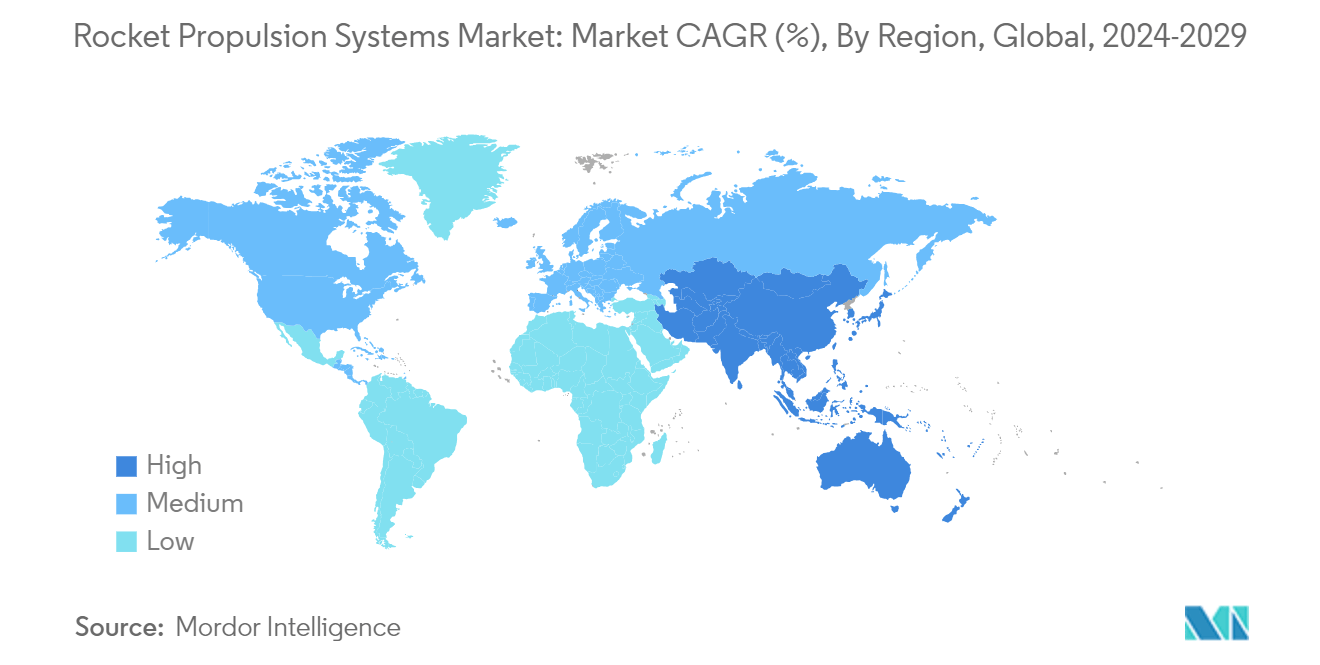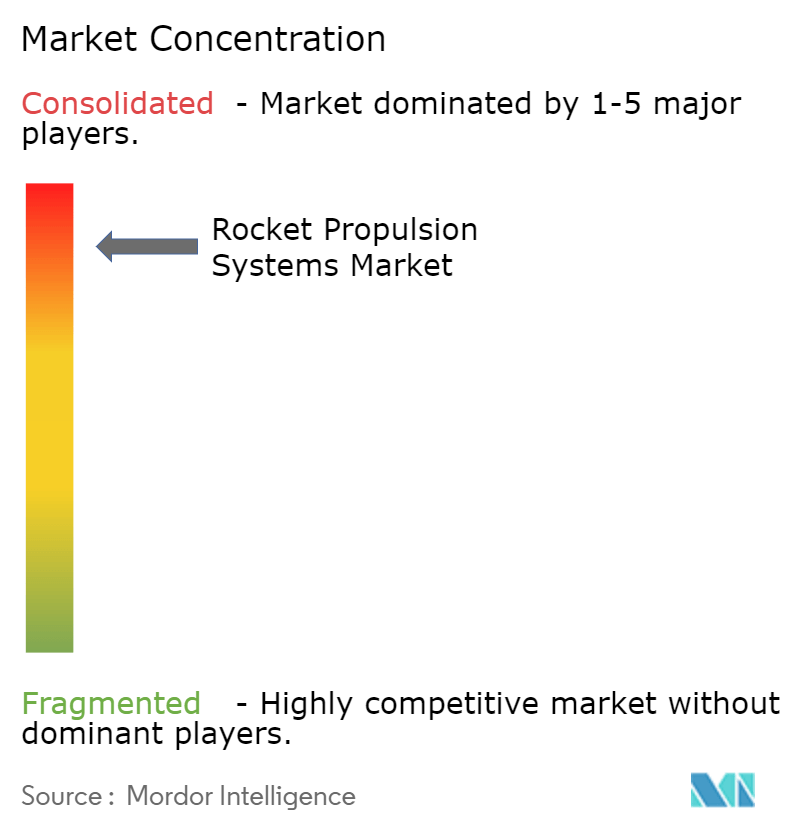Rocket Propulsion Systems Market Analysis
The Rocket Propulsion Systems Market size is estimated at USD 6.54 billion in 2025, and is expected to reach USD 8.57 billion by 2030, at a CAGR of 5.55% during the forecast period (2025-2030).
Major global economies are increasing investments in space centers and satellite launches while emphasizing alternate fuels to reduce carbon footprints. These initiatives are pivotal in driving the space market's growth. Technological advancements are simultaneously reducing manufacturing costs and improving fuel efficiency. Recognizing the potential, government bodies provide substantial investments, especially in R&D, to major industry players. This backing not only encourages continuous innovation but also leads to the emergence of more advanced technologies.
However, the space industry's operational structure makes it uniquely vulnerable to economic shocks. Segments such as space exploration, satellite manufacturing, and scientific endeavors are characterized by specialized, low-volume production and often rely on a limited supplier base.
Despite these challenges, the space sector is experiencing a surge in entrepreneurial activities. This upswing is fueled by technological breakthroughs, increased access to space, and a rising tide of public and private investments. The sector offers abundant opportunities for innovative ventures, from satellite technology to space tourism and even asteroid mining. This wave of entrepreneurship is not only reshaping the industry but also setting the stage for a promising growth trajectory in the coming years.
Rocket Propulsion Systems Market Trends
The Military Segment is Expected to Exhibit Fastest Growth During the Forecast Period
The rocket propulsion market is witnessing a surge, driven primarily by the rising number of satellite launches, especially for military applications. Between 2019 and 2023, 435 satellites were launched, each requiring a specific launch vehicle tailored to its mission and orbit. Atlas 5, Falcon 9, various Long March rockets, Soyuz-2.1b, and Vega have emerged as the preferred choices for these missions.
Major global economies are significantly increasing their allocations to space exploration, focusing on launching satellites and developing advanced rocket engines, particularly for military use. In a notable development in April 2024, ASTROBOTIC TECHNOLOGY, INC. and the US Air Force Research Laboratory (AFRL) Rocket Propulsion Division signed a Cooperative Research & Development Agreement (CRADA). This partnership aims to enhance their capabilities, emphasizing cutting-edge technologies such as liquid and rotating detonation rocket engines (RDREs). It includes on-base rocket flight testing, leveraging Astrobotic's reusable rockets.
The global space arena has seen intense competition for decades, with nations ramping up space launches and research investments. These investments aren't just about exploration; they are strategic moves to lead in emerging space technologies. For instance, in March 2024, China's CASC, a critical state-owned space and defense agency, unveiled plans for a new series of Long March rockets. The Long March 6C, an upgraded version of the Long March 6A, is noteworthy for being China's only rocket with a liquid propellant core and solid-fueled side boosters. With similar ambitious projects in the pipeline from other space agencies, the rocket propulsion systems market is set for significant growth in the coming years.
Asia-Pacific to Witness the Highest Growth During the Forecast Period
Investments in space exploration in the Asia-Pacific, notably from countries like China and India, are set to surge in the coming years. India, in particular, is focusing on enhancing its domestic space launch capabilities. A tangible sign of this commitment was the Indian government's announcement in February 2024, allocating INR 13,042.75 crore (USD 1.55 billion) to the Department of Space for the FY 2024-2025. This marked a notable increase of INR 498.84 crore (USD 59.4 million) from the previous year.
Alongside government efforts, the region's space sector is witnessing a rise in private investments. Both startups and established firms are actively developing state-of-the-art rocket engines. For example, in October 2023, Indian startup Skyroot Aerospace unveiled its Vikram-1 rocket, designed to deploy satellites into low earth orbit by early 2024. Similarly, in May 2024, an IIT Madras-incubated startup launched the world's first rocket with a single-piece 3D printed engine from Sriharikota. This mission, the debut for Agnikul, serves as a technology showcase, validating their systems for the upcoming 'Agnibaan' orbital launch vehicle.
Further bolstering the region's momentum, in April 2024, China's CASC successfully conducted two ground ignition tests for its 130-ton reusable liquid oxygen kerosene engine, showcasing significant advancements in propulsion technology that are poised to drive market demand in the coming years.
Rocket Propulsion Systems Industry Overview
The rocket propulsion systems market remains consolidated and dominated by a few players. Key players include Safran SA, Aerojet Rocketdyne (a division of L3 Harris Technologies Inc.), Mitsubishi Heavy Industries, Ltd., Space Exploration Technologies Corp., and ARIANESPACE SAS.
Numerous companies have established long-term collaborations with government agencies to bolster space exploration capabilities and shape future programs. These companies channel substantial investments into R&D, striving to pioneer advanced products and technologies that could facilitate space discoveries.
For instance, several players are delving into alternative fuel technologies to conserve fuel and minimize carbon footprints. In a notable development, UK-based Orbex showcased its 62-foot-long Prime rocket prototype in May 2022. Set to launch small satellites from the Scottish Highlands, Orbex's final rocket version promises full reusability. It will utilize a renewable biofuel, biopropane, positioning it as the world's most environmentally friendly rocket. Such innovations are poised to accelerate space exploration and launch activities, fueling the market's expansion.
Rocket Propulsion Market Leaders
-
Safran SA
-
Mitsubishi Heavy Industries, Ltd.
-
Space Exploration Technologies Corp.
-
ARIANESPACE SAS
-
Aerojet Rocketdyne (L3 Harris Technologies Inc.)
- *Disclaimer: Major Players sorted in no particular order
Rocket Propulsion Systems Market News
- June 2024: SAST, aiming for reusable rocket capabilities, achieved China's highest altitude launch and landing. The test vehicle soared to around 12 kilometers before touching down successfully at a nearby site, with its landing legs deploying at 50 meters.
- April 2024: ISRO unveiled a significant advancement in rocket engine technology: a lightweight Carbon-Carbon (C-C) nozzle. This innovation, crafted by the Vikram Sarabhai Space Centre (VSSC), promises to enhance crucial engine metrics like thrust levels, specific impulse, and thrust-to-weight ratios, ultimately boosting the payload capacity of launch vehicles.
Rocket Propulsion Systems Industry Segmentation
Rocket propulsion is a critical sub-system of a rocket that propels itself from the ground into the atmosphere. This study delves into the various rocket propulsion systems crucial for space launch vehicles.
The rocket propulsion systems market is segmented by type, end user, and geography. Based on type, the market is segmented into solid, liquid, and hybrid. By end user, the market is segmented into civil and commercial, and military. The report also covers the market sizes and forecasts for the rocket propulsion systems market across different regions. For each segment, the market size is provided in terms of value (USD).
| Type | Solid |
| Liquid | |
| Hybrid | |
| End User | Civil and Commercial |
| Military | |
| Geography | North America |
| Europe | |
| Asia-Pacific | |
| Rest of the World |
Rocket Propulsion Systems Market Research Faqs
How big is the Rocket Propulsion Systems Market?
The Rocket Propulsion Systems Market size is expected to reach USD 6.54 billion in 2025 and grow at a CAGR of 5.55% to reach USD 8.57 billion by 2030.
What is the current Rocket Propulsion Systems Market size?
In 2025, the Rocket Propulsion Systems Market size is expected to reach USD 6.54 billion.
Who are the key players in Rocket Propulsion Systems Market?
Safran SA, Mitsubishi Heavy Industries, Ltd., Space Exploration Technologies Corp., ARIANESPACE SAS and Aerojet Rocketdyne (L3 Harris Technologies Inc.) are the major companies operating in the Rocket Propulsion Systems Market.
Which is the fastest growing region in Rocket Propulsion Systems Market?
Asia-Pacific is estimated to grow at the highest CAGR over the forecast period (2025-2030).
Which region has the biggest share in Rocket Propulsion Systems Market?
In 2025, the North America accounts for the largest market share in Rocket Propulsion Systems Market.
What years does this Rocket Propulsion Systems Market cover, and what was the market size in 2024?
In 2024, the Rocket Propulsion Systems Market size was estimated at USD 6.18 billion. The report covers the Rocket Propulsion Systems Market historical market size for years: 2019, 2020, 2021, 2022, 2023 and 2024. The report also forecasts the Rocket Propulsion Systems Market size for years: 2025, 2026, 2027, 2028, 2029 and 2030.
Our Best Selling Reports
Rocket Propulsion Systems Industry Report
Statistics for the 2025 Rocket Propulsion Systems market share, size and revenue growth rate, created by Mordor Intelligence™ Industry Reports. Rocket Propulsion Systems analysis includes a market forecast outlook for 2025 to 2030 and historical overview. Get a sample of this industry analysis as a free report PDF download.







